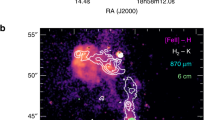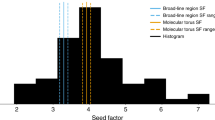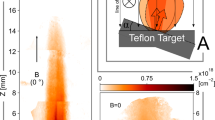Abstract
The mechanism by which astrophysical jets form is an important factor in understanding the nature and evolution of phenomena such as active galactic nuclei and quasars, Galactic superluminal X-ray sources and young stellar objects. Of the many schemes proposed for jet production, only the magnetized accretion disk model of Blandford and Payne1 seems to be applicable to all of these systems, and also offers the potential for generating the highly relativistic flows observed in some quasars2. But the source of variation in jet morphology observed for different sources remains unclear. Here we report time-dependent numerical simulations of jet formation which show that the character and speed of the jets produced depend dramatically on whether magnetic forces dominate over gravity in the accretion disk corona. This ‘magnetic switch’ is not predicted by steady-state, self-similar disk models, or by relativistic wind theory (which generally ignores the gravitational field). The effect provides a natural explanation for the existence of two known classes of extragalactic radio source and for the variation of their properties with radio luminosity. It also provides insight into protostellar and galactic microquasar systems.
This is a preview of subscription content, access via your institution
Access options
Subscribe to this journal
Receive 51 print issues and online access
$199.00 per year
only $3.90 per issue
Buy this article
- Purchase on Springer Link
- Instant access to full article PDF
Prices may be subject to local taxes which are calculated during checkout



Similar content being viewed by others
References
Blandford, R. D. & Payne, D. G. Hydromagnetic flows from accretion discs and the production of radio jets. Mon. Not. R. Astron. Soc. 199, 883–903 (1982).
Vermeulen, R. C. in Extragalactic Radio Sources(eds Ekers, R., Fanti, C. & Padrielli, L.) 56–62 (IAU Symp. No. 175, Kluwer, Dordrecht, (1996)).
Lovelace, R. V. E., Mehanian, C., Mobarry, C. M. & Sulkanen, M. E. Theory of axisymmetric magnetohydrodynamic flows—disks. Astrophys. J. Suppl. Ser. 62, 1–37 (1986).
Kudoh, T. & Shibata, K. Mass flux and terminal velocities of magnetically driven jets from accretion disks. Astrophys. J. 452, L41–L44 (1996).
Uchida, Y. & Shibata, K. Magnetodynamical acceleration of CO and optical bipolar flows from the region of star formation. Publ. Astron. Soc. Jpn. 37, 515–535 (1985).
Stone, J. M. & Norman, M. L. Numerical simulations of magnetic accretion disks. Astrophys. J. 433, 746–756 (1994).
Bell, A. R. & Lucek, S. G. Magnetohydrodynamic jet formation. Mon. Not. R. Astron. Soc. 277, 1327–1340 (1995).
Matsumoto R. in Accretion Phenomena and Related Outflows (IAU Colloq. No. 163, in the press).
Koide, S., Shibata, K. & Kudoh, T. in Accretion Phenomena and Related Outflows(IAU Colloq. No. 163, in the press).
Ustyugova, G. V., Koldoba, M. M., Romanova, V. M., Chechetkin, V. M. & Lovelace, R. V. E. Magnetohydrodynamic simulations of outflows from accretion disks. Astrophys. J. 439, L39–L42 (1995).
Ouyed, R., Pudritz, R. E. & Stone, J. M. Episodic jets from black holes and protostars. Nature 385, 409–414 (1997).
Bachiller, R. Bipolar molecular outflows from young stars and protostars. Annu. Rev. Astron. Astrophys. 34, 111–154 (1996).
Eislöffel, J. in Jets from Stars and Galactic Nuclei(ed. Kundt, W.) 104–117 (Lecture Notes in Physics, Vol. 471, Springer, Berlin, (1996)).
Blandford, R. D. & Rees, M. J. in Testing the AGN Paradigm(eds Holt, S. S., Neff, S. G. & Urry, C. M.) 3–19 (AIP Conf. No. 254, Am. Inst. Phys., College Park, MD, (1991)).
Fanaroff, B. L. & Riley, J. M. The morphology of extragalactic radio sources of high and low luminosity. Mon. Not. R. Astron. Soc. 167, 31P–35P (1974).
Bicknell, G. V. The relationship of the Fanaroff–Riley classification of extragalactic radio-sources to jet physics. Publ. Astron. Soc. Aust. 6, 130–137 (1985).
Ledlow, M. J. & Owen, F. N. 20-cm VLA survey of Abell clusters of galaxies. VI. Radio/optical luminosity functions. Astron. J. 112, 9–22 (1996).
Li, Z. -Y., Chiueh, T. & Begelman, M. C. Electromagnetically driven relativistic jets: a class of self-similar solutions. Astrophys. J. 394, 459–471 (1992).
Goldreich, P. & Julian, W. H. Stellar winds. Astrophys. J. 160, 971–977 (1970).
Henriksen, R. N. in Accretion Disks and Magnetic Fields in Astrophysics(ed. Belevedere, G.) 117–128 (Kluwer, Dordrecht, (1989)).
Camenzind, M. in Accretion Disks and Magnetic Fields in Astrophysics(ed. Belevedere, G.) 129–143 (Kluwer, Dordrecht, (1989)).
Hjellming, R. M. in Accretion Phenomena and Related Outflows(IAU Colloq. No. 163, in the press).
Meier, D. L. in Accretion Phenomena and Related Outflows(IAU Colloq. No. 163, in the press).
Shakura, N. I. & Sunyaev, R. A. Black holes in binary systems. Observational appearance. Astron. Astrophys. 24, 337–355 (1973).
Lind, K. R., Payne, D. G., Meier, D. L. & Blandford, R. D. Numerical simulations of magnetized jets. Astrophys. J. 344, 89–103 (1989).
Acknowledgements
We thank R. Linfield, R. Ouyed, R. Hjellming and K. Meisenheimer for comments on the manuscript. Part of this research was carried out at the Jet propulsion Laboratory, under contract to NASA. S.E. was an associated Western Universities Summer fellow; P.G. was a National Research Council research associate at the NASA Jet Propulsion Laboratory.
Author information
Authors and Affiliations
Corresponding author
Rights and permissions
About this article
Cite this article
Meier, D., Edgington, S., Godon, P. et al. A magnetic switch that determines the speed of astrophysical jets. Nature 388, 350–352 (1997). https://doi.org/10.1038/41034
Received:
Accepted:
Issue Date:
DOI: https://doi.org/10.1038/41034
Comments
By submitting a comment you agree to abide by our Terms and Community Guidelines. If you find something abusive or that does not comply with our terms or guidelines please flag it as inappropriate.



